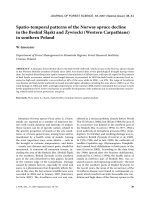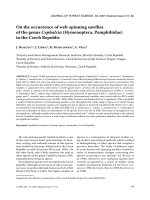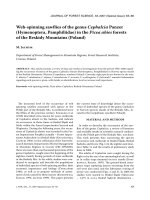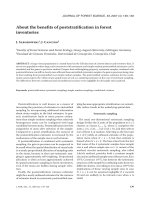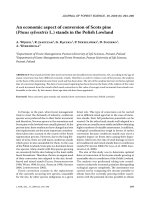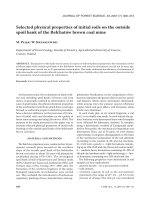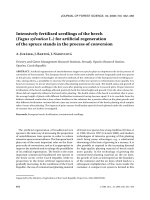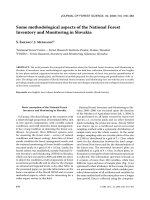Báo cáo lâm nghiệp:"Predicting the probability of seed germination in Pinus sylvestris L. and four competitor shrub species after fire" doc
Bạn đang xem bản rút gọn của tài liệu. Xem và tải ngay bản đầy đủ của tài liệu tại đây (178.3 KB, 7 trang )
75
Ann. For. Sci. 60 (2003) 75–81
© INRA, EDP Sciences, 2003
DOI: 10.1051/forest: 2002076
Original article
Predicting the probability of seed germination in Pinus sylvestris L.
and four competitor shrub species after fire
Mª Rosario Nuñez
a
, Felipe Bravo
a
and Leonor Calvo
b
*
a
Departamento de Producción Vegetal y Silvopascicultura, E.T.S. de Ingenierías Agrarias, Universidad de Valladolid, Avda. de Madrid, nº 57,
34004 Palencia, Spain
b
Área de Ecología, Facultad de Ciencias Biológicas y Ambientales, Universidad de León, 24071 León, Spain
(Received 8 April 2002; accepted 4 June 2002)
Abstract – Knowledge of the regeneration of competing shrub species after wildfire in Scots pine stands is essential for the regeneration of this
tree species. The germination capability of seeds is modified by the temperature reached during a fire and the length of time that seeds are subjected
to high temperatures. The probability of germination was studied in the laboratory for Scots pine (Pinus sylvestris) and four shrub species
characteristic of the understory in Scots pine stands in northern Spain (Cistus laurifolius, Halimium umbellatum, Halimium alyssoides and Genista
florida). Germination probability was studied with a logistic model that uses duration of exposure to the fire, the temperature and the interaction of
both as independent variables. Results show a higher germination rate in shrub species at high temperature than for Scots pine. Thus by limiting
competition between Scots pine and understory species, using prescribed burning or mechanical site preparation, Scots pine can regenerate
successfully and quickly. This model can aid management decisions in this area.
germination / scots pine / shrub species / thermal shock
Résumé – Prédiction des probabilités de germination après le feu de Pinus sylvestris L. et de quatre espèces de garrigue. La régénération
des espèces de garrigue après le feu est un facteur déterminant pour la réinstallation de Pinus sylvestris. La température pendant l’incendie et
la durée de l’exposition modifient la capacité de germination des graines. Nous avons étudié au laboratoire la germination de Pinus sylvestris
et de quatre espèces de garrigue (Cistus laurifolius, Halimium umbellatum, Halimium alyssoides et Genista Florida) qui sont typiques des forêts
dominées par Pinus sylvestris. Afin de définir les probabilités de germination, on a utilisé la durée de l’exposition, la température et son
interaction comme variables indépendantes, dans un modèle logistique. Les résultés de la germination suggèrent que les graines des espèces de
garrigue présentent une meilleure germination après exposition à des hautes températures que les graines de Pinus sylvestris. En conséquence,
les feux prescrits ou les entretiens mécaniques peuvent provoquer une régénération plus rapide et plus satisfaisante de Pinus sylvestris.
dynamique de germination / Pinus sylvestris / espèces du maquis / feu de forêt
1. INTRODUCTION
Scots pine (Pinus sylvestris L.) is one of the most important
forest species across Europe from the boreal region in northern
and eastern areas to the Mediterranean mountains in the south-
ern part of the continent. An accurate assessment of the regen-
eration process of these stands is a key concept for sustainable
management. This is true especially in the limits of its distri-
bution in the Mediterranean basin. At present, forest fires are
the most important cause of damage to the natural environ-
ment in the Mediterranean basin [51]. Amongst the countries
of the Mediterranean basin, Spain is one of those with a rela-
tively high fire risk and severity of burning [50]. Within Spain,
León is the province with the largest wooded surface area
burned in the last few years. Forty per cent of this area is cov-
ered by coniferous species, mainly Pinus sylvestris and Pinus
nigra, and the remaining 60% by Quercus species (Del Hierro,
personal communication).
Different factors must be considered in the post-fire succes-
sion. For example, vegetation characteristics before fire, fire
temperature and fire intensity, ash concentration, nutrient bal-
ance, soil and air temperature, animal population associated to
forest ecosystem, etc. All these factors together determine the
vegetation response after forest fire [1, 25, 27].
The effects of fire on vegetation are usually the most obvi-
ous impact of burning. Fire affects natural ecosystems by con-
suming plants, altering successional patterns and changing
vegetative resources such forage, wildlife habitats, etc. Under-
standing how fire affects vegetation is often a key to holistic,
ecosystem-based, natural resource management [12].
* Correspondence and reprints
Tel.: 34-987-291567; fax: 34-979-291501; e-mail:
76 R. Nuñez et al.
Natural regeneration in Scots pine (Pinus sylvestris L.)
stands has been well studied in boreal and Atlantic areas.
Regeneration processes in these ecosystems have also been
widely studied in the Mediterranean environment [6–8, 17, 18,
37, 38, 40, 42
] where fire is an important ecological factor.
Interspecific competition is considered one of the key param-
eters in the regeneration process of tree species but natural
regeneration can be affected by community composition.
González Martínez and Bravo [19
] found that the regeneration
density of Scots pine stands is negatively related to the cover
of Ericaceae species and Quercus species in northern Spain.
Differences in linear growth rates for Scots pine compared
with exponential growth rates for the initial stages of oak spe-
cies [35
], cause a clear initial competitive disadvantage for
pine regeneration. Other factors, such as the quantity of seeds
produced, depredation by herbivores, allelopathic effects
among species or damage by cattle, have been suggested as
explanatory variables for the same process [2, 19, 23
]. Simi-
larly, modifying the germination capacity of different species
competing in a specific area may be one of the most significant
factors affecting the competitive potential of the species
involved. In the case of regeneration after a forest fire, the fac-
tors most likely to alter the germinative capacity are the tem-
perature reached by the fire and its duration. Scots pine is an
obligated seeder that does not show allelopathic effects as it
occurs in other conifer species. Other coniferous species have
been found capable of producing allelopathic substances, as
occurs in the case of Pinus halepensis, which emits a consid-
erable amount of terpenes [29], Picea abies, which emits phe-
nol compounds from the green acicules to the soil solutions
[16] and Pinus pinaster, which presents different amounts of
terpenes and resinous acids in its acicules and bark [15]. These
compounds act as powerful agents, which inhibit the germina-
tion and the growth of some herbaceous species when found in
the substratum [25].
Previously, Escudero et al. [14] studied the germination
probability of Spanish pines. In the field, regeneration
involves different processes, including interspecific competi-
tion, but no study has modeled the behaviour of a pine species
and its potential competitor in order to assist management
actions. For this reason, this study is devoted to analysing the
germination pattern of Scots pine and four potential competi-
tors following thermal treatment. Finally, conclusions allow
the development of management strategies to help regenerate
Scots pine stands in northern Spain.
2. MATERIALS AND METHODS
The biological materials used in this study were seeds of Pinus
sylvestris, Halimium umbellatum, Halimium alyssoides, Genista
florida and Cistus laurifolius.
Two species that can be considered as colonisers are Halimium
alyssoides and Halimium umbellatum. These species used germina-
tion as a regeneration mechanism and both of them take advantage of
the empty spaces to germinate and increase cover as well as the space
they occupy [7]. The beneficial effects of thermal shock on the seeds
of these species have been widely studied [36]. However, in this
study, cutting and ploughing also had a significant positive effect on
the germination of these species. Therefore perturbations that create
open spaces favour both species.
Genista florida is a legume that uses both seeds and sprouting to
regenerate, but after fire the germination is promoted [37]. Finally,
Cistus laurifolius proliferating appreciably in some burnt areas, are
among those considered as heliophylous that colonize the altered
areas, free of aggressive competitors [42]. Cistus laurifolius repro-
duce actively after fire but only via seeds.
The seeds of Pinus sylvestris were obtained from the Dirección
General de Conservación de la Naturaleza, Ministerio de Medio
Ambiente (1994–1995 harvest); the source region used was the
“Montaña soriano-burgalesa”, northern Spain. The seeds of the shrub
species were obtained from shrub formations that represent Scots
pine undergrowth in northern Spain (León Province and Palencia
province). After eliminating damaged seeds, the remainders were
stored in open paper bags, which permitted ventilation, in a dry place
at laboratory temperature until they were used. In order to discover
the effect of fire on germination, a method widely used by various
authors [37, 44] was employed. This method consists of exposing
seeds to high temperatures for short periods of time in order to simu-
late the action of fire under conditions, which are as natural as possi-
ble. According to Trabaud [41], the heat of a fire operates on a
concrete point for only a short period of time (between 5 and 15 min)
and the temperatures reached at 2.5 cm below the soil surface varies
between 44 and 150 ºC. Pinus sylvestris seeds were subjected to dif-
ferent thermal shocks: 70 ºC, 90 ºC, 110 ºC, 130 ºC, 150 ºC, 170 ºC,
190 ºC for 1 and 5 minutes and control treatment (no thermal treat-
ment). In accordance with others authors the shrub seeds were sub-
jected to the following treatments: 50 ºC, 75 ºC, 100 ºC and 125 ºC
for 1, 5, 10 and 15 minutes and a control treatment. The control was
included in the data analysis as 20 ºC and one minute following Escu-
dero et al. [14]. As we use a modeling approach (see below), the use
of different temperature and time exposure values for each species
doesn’t matter.
Immediately after treatments the seeds were sown in 8.5 cm diam-
eter Petri dishes on four layers of filter paper saturated with deminer-
alised water. There were 5 replicates of 20 seeds for each treatment.
These treatments were compared with another group of 5 replicates,
which were not subjected to thermal shock. The dishes were placed
in a controlled environment cabinet at a temperature of 20 ºC ± 1 ºC
with photoperiods of 15 hours light/9 hours dark, according with
other experimental studies involving this species (Torres et al.,
unpublished data). A temperature of 20 ºC was used, like in other ger-
mination studies where temperatures used varied between 20 ºC and
23 ºC [45]. The number of germinating seeds was counted every
week for 6 weeks. A seed was considered to have germinated when
the radicle could be seen with the naked eye [9].
Logistic regression [30] was used to determine whether the
explanatory variables allowed germination probability after thermal
treatment to be predicted. Logistic regression is a straightforward
method of analysing processes such as death, survival or germination
and has been used previously in forest ecology [5, 14]. The exposure
time to the thermal treatment and the temperature at which the seeds
were subjected were used as explanatory variables. The full model
(temperature, time and their interaction), including independent
terms, and all reduced models were tested. The logistic model is
expressed as:
where p is the germination probability and z a linear function which
contains the explanatory variables considered (Z = a
0
´ temperature
+ a
1
´ time + a
2
´ temperature ´ time). The coefficients of the z func-
tion are obtained using maximum likelihood function. The models
were selected using the change in the value of – 2 log likelihood
between the model with and without explanatory variables [22]. Plant
nomenclature follows Tutin et al. [47].
p
1
1 e
–z
+
=
Models of germination of competitor species 77
3. RESULTS
Germination results of Scots pine and the four undergrowth
species (table I) indicate that the four obligatory seeder species
(Pinus sylvestris, Cistus laurifolius, Halimium alyssoides and
H. umbellatum) behave differently under thermal treatment.
Results from the control situation are similar to previous
works [48, 49]. The only exception is Halimium alyssoides,
which show germination rates low in the control situation.
Scots pine reached its maximum germination rates at rela-
tively low temperatures (70 ºC–90 ºC) and without significant
differences from control treatment. Germination rates
decrease significantly at temperatures higher than 110 ºC and
an exposure time of five minutes. Cistus laurifolius shows rel-
atively high germination rates, similar to the control, up to
125 ºC and an exposure time of 15 minutes. So, this species
possesses a high resistance against high temperatures. The two
Halimium species analysed show completely different behav-
iour to that of Scost pine because they exhibit maximum ger-
mination rates at high temperatures (between 100 and 125 ºC)
and long exposure time, but their embryos were killed at
125 ºC for 15 min. In our study Genista florida (simultane-
ously a sprouter and seeder species) show good germination
rates at high temperatures.
From laboratory results, different logistic models for Pinus
sylvestris, Cistus laurifolius, Halimium umbellatum, Halim-
ium alyssoides and Genista florida were tested using the ger-
mination results after thermal shock. The value of –2 log like-
lihood and the variable significance were used for this.
Different models were selected for each species (table II).
Using the fitted models, the germination probability of the five
species studied was calculated for different conditions
(figure 1). It is important to note that in some cases the model
is used out of the original data set range. The results obtained
show that Pinus sylvestris has the greatest germination proba-
bility with low exposure temperatures (up to 100 ºC). As the
exposure time increases, the species resists these temperatures
less. Thus, with an exposure time of 1 minute, the probability
of germination decreases significantly above 120 ºC. With an
exposure time of 5 minutes this decrease occurs at 100 ºC; and
with times of 10 and 15 minutes harmful temperatures are
lower. In the thermal treatments that allow maximum germi-
nation probabilities to be obtained, there are no differences in
germination probability between these and the control situa-
tion (20 ºC).
Cistus laurifolius exhibits special behaviour, as it has the
same germination probability in both the control situation and
at the different temperatures, although this probability
decreases slightly when the exposure times increase. In the
case of Genista florida and Halimium umbellatum (figure 1)
the germination probabilities remain practically constant
throughout the thermal range with exposure times of 1 and
5 minutes. However, with exposure times of 10 and 15 min-
utes a clear decrease in germination is observed when the tem-
perature increases. Thus, at temperatures above 160 ºC, the
germination probability is below 1%. The behaviour of Halim-
ium alyssoides (figure 1) contrasts with the previous two species.
In general, the model predicts that for all shrub species, the
temperature required for a higher germination probability than
Pinus sylvestris, decreases as exposure time increases.
All fitted models contain exposure time as an explanatory
variable (tables II and III). In the case of the seeds of Pinus
sylvestris and Halimium alyssoides, temperature is also signif-
icant. Finally, the interaction between the time and the temper-
ature was only significant in the cases of Pinus sylvestris,
Halimium umbellatum and Genista florida. The correct classi-
fication percentage, using the selected models, varies between
more than 95% in the case of Scots pine and 43% in the case
of Cistus laurifolius. Table III shows the coefficients of the
selected models
4. DISCUSSION
Competition between tree, shrub and herb species for
resources like water can limit the success of arboreal regen-
eration in a forest ecosystem after fire [11, 19
]. This is espe-
cially important in areas with sandy soils where edaphic water
retention is low. Bravo and Montero [4
] established that the
sandy soil in pine stands in northern Spain are areas of low
productivity. However, González Martínez and Bravo [18
]
state that there is no relationship between height growth and
site productivity in young Scots pine stands in northern Spain.
It is well known in practical forestry in Spain that the presence
of Genista florida [28, 33, 34] and other competitor species
such as hardwoods or Ericaceae [18] are associated with prob-
lems in the regeneration of Scots pine stands. In these cases,
limiting competition between species may favour pine stand
regeneration. A possible method to achieving this could be
prescribed burning to limit interspecies competition. It is well
established that the fire regime has important implications for
Tab l e I. Percentage of germination of Pinus sylvestris and four shrub species after different thermal chocks and control situation.
Control 50ºC 75ºC 100ºC 125ºC
1 min 5 min 10 min 15 min 1 min 5 min 10 min 15 min 1 min 5 min 10 min 15 min 1 min 5 min
10 min 15 min
Halimium alyssoides 4 0 2 1 4 2 6 1 2 4 28 44 62 7 52
54 7
Halimium umbellatum 16 4 7 2 3 7 4 8 14 3 12 12 32 48 6
1 0
Cistus laurifolius 68 52615643565936495244546656 60
54 1
Genista florida 2312171820213123202246304342 28
13 2
Control 70 ºC 90 ºC 110 ºC 130 ºC 150 ºC 170 ºC 190 ºC
1 min 5 min 1 min 5 min 1 min 5 min 1 min 5 min 1 min 5 min 1 min 5 min 1 min 5 min
Pinus sylvestris 94 94 95 93 90 92 8 78 0 27 0 0 0 0 0
78 R. Nuñez et al.
plant community composition within ecosystems [12, 52]. As
indicated by Hanley [20
], the growth responses of seeds that
have been subjected to thermal treatment may provide some
clues as to how fire-adapted regeneration strategies influence the
patterns of recruitment observed in post-fire plant communities.
In these pine stand communities after burning, species with
different recovery strategies appear: some are obligate seeders
like Pinus sylvestris, Cistus laurifolius, Halimium alyssoides
and Halimium umbellatum, others use vegetative sprouting,
and finally there are those that can use both mechanisms, such
as Genista florida. Species that can regenerate both by sprout-
ing and seeding tend to reproduce by sprouting, since it allows
them to quickly reoccupy the available space [26, 41
].
In general, the germination of many of the obligate seeder
species, as Cistus spp., Halimium spp. and Pinus spp., is stim-
ulated by increased heat [31
]. However, their germination
does not depend exclusively on the thermal increase caused by
fire [21, 42
], as they also germinate under control conditions.
The viability of seeds and the survival of seedlings in natural
conditions are key factors for sexual regeneration of woody
species [3]. In addition, the regeneration of Pinus depends on
the presence or absence of seed sources in and near the burne
sites.
The beneficial effect on germination produced by thermal
shock in many of these species, such as the Cistaceae family:
Halimium alyssoides, Halimium umbellatum and Cistus lauri-
folius, can be compared with that found by other authors in the
Mediterranean area [10, 21, 36–40, 46, 48]. As Cistaceae spe-
cies show a high germination rate after thermal shock, there is
a high probability that these species produce a reduction in the
Table I I. Main characteristics of the logistic models fitted for the species studied.
Species Model –2 Log L
(constant)
–2 Log L
(model)
Correct classification (%)
Pinus sylvestris T 2062.768 1021.425 90.1
t 1902.824 43.6
T, t 777.843 95.5
T, t, T*t 699.807 95.8
Halimium umbellatum T 1028.629 1026.154 42.7
T 1011.364 47.6
T, t 1006.268 56.7
T, t, T*t 988.884 54.9
T, T*t 993.147 54.7
Halimium alyssoides T 1419.749 1373.652 51.7
T 1227.480 65.5
T, t 1193.687 77.3
T, t, T*t 1192.349 77.4
Genista florida T 1332.595 1331.653 41.0
t 1332.453 38.7
T, t 1331.368 47.8
T, t, T*t 1321.528 53.4
T, T*t 1324.394 51.8
Cistus laurifolius T 2343.092 2337.852 41.8
T 2325.600 43.0
t # 2327.073 43.0
T, t 2322.092 53.2
T, t, T*t 2316.731 52.5
T: Temperature; t: time; #: model without independent term; – 2 Log L is the – 2 log likelihood including only the constant of the complete model.
The models in bold are the selected ones. The coefficients of the variables in italics are not significant using a probability level of 0.05.
Table III. Coefficients of the selected logistic models.
Species Independent term T t T*t
Pinus sylvestris 5.8138 –0.0307 2.3153 –0.0292
Halimium umbellatum –2.8443 - 0.1722 –0.00129
Halimium alyssoides –4.8884 0.0150 0.1928 -
Genista florida –1.9149 - 0.0727 –0.0008
Cistus laurifolius - - –0.0293 -
T: Temperature; t: time. All parameters with P > 0.0001.
Models of germination of competitor species 79
regeneration of trees in Scots pine stands. So as previously
demonstrated by other authors works, vegetation-control treat-
ment is highly recommended to improve Scots pine trees
regeneration.
In the case of Pinus sylvestris, the germination probability
in the control situation is similar to that found in thermal treat-
ments up to approximately 90 ºC. This probability is consider-
ably reduced at higher temperatures and high exposure times.
These results correspond with those reported by Escudero
et al. [13
] that show that temperatures above 70 ºC and an
exposure time of 5 minutes are lethal to germination. Reyes
and Casal [31, 32
] found that the critical point must be located
between 90 ºC/1 min and 90 ºC/5 min. The behaviour of this
species of Pinus allows us to suggest that it is not a pyrophyte
but is probably an opportunist species that can germinate very
well when strong competitors are not present. Similar results
have been presented by Trabaud [43
] in studies with Pinus
halepensis. However, clear differences between Scots and
Aleppo pines have also been observed [27
].
Limited seedling recruitment in forest species due to inter-
specific competition is widely recorded elsewhere. It has been
reported that shrub species affect Scots pine regeneration [19
].
Although spatial heterogeneity [24
] and an efficient dispersal
strategy [14
] have been suggested as possible explanations for
height growth in Scots pine, interspecific competition can also
explain the multicohort stand dynamic found in Scots pine
stands [19
].
Field data show than one year after a fire, the density of
pine seedlings is less than 3 per square metre (unpublished
data), while the cover of shrub species reaches over 50%. So,
it is clear than competition from shrubs can make natural
regeneration of Scots pine difficult in northern Spain.
Therefore, in practical forestry limiting competition by pre-
scribed burning or mechanical site preparation could favour
successful and rapid Scots pine regeneration. An increase of
0.03 to 1.3 seedlings m
–2
has been predicted when a site is pre-
pared [19
]. Prescribed burning can be used as a silvicultural
alternative to improve regeneration practices, especially with
Figure 1. Germination probability of the species studied. It must be considered that in some temperature and time exposure combinations, the
logistic models are used out of the original data set, so the graphs show extrapolations in some situations. ps: Pinus sylvestris; ha: Halimium
alyssoides; hu: Halimium umbellatum; gf: Genista florida; and cl: Cistus laurifolius.
80 R. Nuñez et al.
temperatures under 90 ºC and short exposure times to fire
which give Scots pine the advantage over its shrub competi-
tors. Due to social concerns about forest fires, the use of pre-
scribed burning is limited in Spain. Each tree or shrub species
responds differently to increased temperatures. An under-
standing of these differences allows possible management
actions on these communities to be identified. It can be
deduced from the results obtained (figure 1) that a prescribed
fire moving at high speed (one minute residence time) has
practically no effect on the germination probability of Scots
pine seeds, so this species will benefit from this form of inter-
vention. In contrast, a prescribed fire with a long residence
time (10 minutes or longer) harms the germinative capacity of
Scots pine seeds when the temperature exceeds 90 ºC, favour-
ing the competitor shrub species. Núñez and Calvo [27
] found
that high temperatures did not benefit the germination of Pinus
sylvestris. In contrast, Tárrega et al. [37
] recorded that high
temperatures favoured the germination of Genista florida.
Therefore, a balance between the elimination of competitor
shrub species and the stimulation of the germination of Pinus
sylvestris seeds must be considered when prescribed burning
is used to ensure the regeneration of Scots pine. In addition,
other aspects, such as seed production, initial growth of seed-
lings, loss of nutrients after a fire or economic considerations,
must be tackled before proposing the extension of prescribed
fires as an alternative means of favouring the regeneration of
Scots pine.
REFERENCES
[1] Ahlgren C.E., Some effects of fire on reproduction and growth of
vegetation in northeastern Minnesota, Ecology 41 (1960) 431–444.
[2] Almqvist C., Bergsten U., Bondesson L., Eriksson U., Predicting
germination capacity of Pinus sylvestris and Picea abies seeds
using temperature data from weather stations, Can. J. For. Res. 28
(1998) 1530–1535.
[3] Bationo B.A., Ouedraog S.J., Guinko S., Longévité des graines et
contraintes à la survie des plantules d’Afzelia africana Sm. dans une
savane du Burkina Faso, Ann. For. Sci. 58 (2001) 69–75.
[4] Bravo F., Montero G., Site index estimation in Scots pine (Pinus
sylvestris L.) stands in the High Ebro Basin (northern Spain) using
soil attributes, Forestry 74 (2001b) 395–406.
[5] Bravo F., Hann D.W., Maguire D.A., Impact of competitor species
composition on predicting diameter growth and survival rates of
Douglas-fir trees in southwestern Oregon, Can. J. For. Res. 31
(2001a) 2237–2247.
[6] Calvo L., Tárrega R., Luis E., Regeneration in Quercus pyrenaica
ecosystems after surface fires, Int. J. Wild. Fire 1 (1991) 205–210.
[7] Calvo L., Tárrega R., Luis E., Space-time distribution patterns of
Erica australis L. subsp. aragonensis (Willk) after experimental
burning, cutting, and ploughing, Plant Ecol. 137 (1998a) 1–12.
[8] Calvo L., Tárrega R., Luis E., Twelve years of vegetation changes
after fire in an Erica australis community, in: Trabaud L. (Ed), Fire
management and landscape ecology, International Association of
Wildland Fire, Fairfield, Washington, 1998, pp. 123–136.
[9] Come D., Les obstacles à la germination, Masson, Paris, 1970.
[10] Corral R., Pita J.M., Pérez-García F., Some aspects of seed
germination in four species of Cistus L., Seed Sci. Technol. 18
(1990) 321–325.
[11] Davis M.A., Wrage K.J., Reich P.B., Competition between tree
seedling and herbaceous vegetation: support for a theory of
resource supply and demand, J. Ecol. 86 (1998) 652–661.
[12] DeBano L.F., Neary D.G., Folliott P.F., Fire’s effects on
ecosystems, John Wiley & Sons, Inc., New York, 1998.
[13] Escudero A., Barrero S., Pita J.M., Effects of high temperatures and
ash on seed germination of two Iberian pines (Pinus nigra ssp.
Salzmannii, Pinus sylvestris var iberica), Ann. Sci. For. 54 (1997)
553–562.
[14] Escudero A., Sanz M.V., Pita J.M., Pérez-García F., Probability of
germination after heat treatment of native Spanish pines, Ann. For.
Sci. 56 (1999) 511–520.
[15] Fernández De Simón B., García-Vallejo M.C., Cadahía E., Arrabal
C., Cortijo M., Variación estacional de la composición terpénica de
la acícula de Pinus pinaster Ait. III Congreso Forestal Español
Tomo II, Granada, 2001, pp. 703–709.
[16] Gallet C., Pellissier F., Phenolic compounds in natural solutions of
a coniferous forest, J. Chem. Ecol. 23 (1997) 2401–2412.
[17] González Martínez S.C., Bravo F., Regeneración natural,
establecimiento y primer desarrollo del pino silvestre (Pinus
sylvestris L.) Invest. Agr.: Sist. Recur. For.: Fuera de Serie nº1
(1999) 225–247.
[18] González Martínez S.C., Bravo F., Efecto de la calidad de estación
en el crecimiento de la regeneración natural del pino silvestre
(Pinus sylvestris L.) en el Alto Valle del Ebro (Burgos), Reunión de
la SECF sobre Regeneración Natural, Lugo (Spain), 2000.
[19] González Martínez S.C., Bravo F., Density and population
structure of the natural regeneration of Scots pine (Pinus sylvestris
L.) in the High Ebro basin (northern Spain), Ann. For. Sci. 58
(2001) 277–288.
[20] Hanley E., Fenner M., Pre-germination temperature and the
survivorship and onward growth of Mediterranean fire-following
plant species, Acta Oecol. 19 (1998) 181–187.
[21] Herranz J.M., Ferrandis P., Martínez-Sánchez J.J., Influence of heat
on seed germination of nine woody Cistaceae species, Int. J. Wild.
Fire 9 (1999) 173–182.
[22] Hosmer D.W. Jr., Lemeshow S., Applied logistic regression, John
Wiley and Sons, New York, 1999.
[23] Jäderlund A., Zackrisson O., Nilssön M.C., Effects of bilberry
(Vaccinium myrtillus L.) litter on seed germination and early
seedling growth of four boreal tree species, J. Chem. Ecol. 22
(1996) 973–986.
[24] Kuuluvainen T., Hokkanen T.J., Järvinen E., Pukkala T., Factors
related to seedling growth in a boreal Scots pine stand: a spatial
analysis of a vegetation-soil system, Can. J. For. Res. 23 (1993)
2101–2109.
[25] López Mosquera M.E., Guillén L., Primeros datos sobre el empleo
de corteza de pino tratada para el control de malas hierbas, Actas
del Congreso de la Sociedad Española de Malherbología (1993)
272–275.
[26] Naveh Z., The evolutionary significance of fire in the Mediterra-
nean region, Vegetatio 29 (1975) 199–208.
[27] Nuñez M.R., Calvo L., Effect of high temperatures on seed
germination of Pinus sylvestris and Pinus halepensis, For. Ecol.
Manage. 131 (2000) 183–190.
[28] Morillo J.M., Estudio de las causas que limitan la regeneración
natural de Pinus sylvestris L. en el cuartel D del monte Cabeza de
Hierro. BSc thesis, EUITF-UPM, Madrid, 1987.
[29] Peñuelas J., Llusia J., Influence of intra- and inter-specific interfer-
ence on terpene emission by Pinus halepensis and Quercus ilex
seedlings, Biol. Plant. 41 (1998) 130–143.
[30] Ramsey F., Schaffer D., The statistical sleuth. A course in methods
of data analysis, Duxbury Press, Belmont, CA, 1997.
[31] Reyes O., Casal M., Germination behaviour of 3 species of the
genus Pinus in relation to high temperatures suffered during forest
fires, Ann. Sci. For. 52 (1995) 385–392.
[32] Reyes O., Casal M., The influence of seed age on germinative
response to the effects of fire in Pinus pinaster, Pinus radiata and
Eucalyptus globulus, Ann. For. Sci. 58 (2001) 439–447.
[33] Rubio L.V., Estudio de las causas que limitan la regeneración
natural de Pinus sylvestris L. en el cuartel B del monte Cabeza de
Hierro. BSc thesis, EUITF-UPM, Madrid, 1987, 380 p.
Models of germination of competitor species 81
[34] Santos M., Estudio de las causas que limitan la regeneración natural
de Pinus sylvestris L. en el cuartel E del monte Cabeza de Hierro.
BSc thesis, EUITF-UPM, Madrid, 1987.
[35] Schepper (De) C., Typology of the natural regeneration in a middle-
aged Scots pine forest, Silva Gandavensis 53 (1988) 29–60.
[36] Thanos C.A., Georghiou K., Kadis C.C., Pantazi C., Cistaceae: A
plant family with hard seeds, Isr. J. Bot. 41 (1992) 251–263.
[37] Tárrega R., Calvo L., Trabaud L., Effect of high temperatures on
seed germination of two woody Leguminosae, Vegetatio 102
(1992) 139–147.
[38] Tárrega R., Luis E., Alonso I., Comparison of the regeneration after
burning, cutting and ploughing in a Cistus ladanifer shrubland,
Vegetatio 120 (1995) 56–67.
[39] Thanos G.A., Georghiou K., Ecophysiology of fire-stimulated seed
germination in Cistus incanus subsp. creticus (L.) Heywood and C.
salvifolius L., Plant Cell Environ. 11 (1988) 841–849.
[40] Thanos G.A., Marcou S., Christodoulakis P., Yannitsaros A., Early
post-fire regeneration in Pinus brutia forest ecosystems of Samos
island (Greece), Acta Oecol Oecol. Plant. 10 (1989) 79–94.
[41] Trabaud L., Dynamics after fire of sclerophyllous plant communi-
ties in the Mediterranean basin, Ecol. Medit. 13 (1987) 25–37.
[42] Trabaud L., Modalités de germination des cistes et des pins
méditerranéens et colonisation des sites perturbés, Rev. Ecol.
(Terre Vie) 50 (1995) 3–14.
[43] Trabaud L., Post-fire regeneration of Pinus halepensis forest in the
west mediterranean, in: Neèman G., Trabaud L. (Eds.), Ecology,
biogeography and management of Pinus halepensis and P. brutia
forest ecosystems in the Mediterranean basin, Backhuys
Publishers, 2000, pp. 257–268.
[44] Trabaud L., Casal M., Réponses des semences des Rosmarinus
officinalis à différents traitments simulant une action de feu, Acta
Oecol. 10 (1989) 355–363.
[45] Trabaud L., Oustric J., Heat requirements for seed germination of
three Cistus species in the garrige of Southern France, Flora 183
(1989) 321–325.
[46] Trabaud L., Oustric J., Influence du feu sur la germination des
semences de quatre espèces ligneuses méditeranéennes à
reproduction sexuée obligatoire, Seed Sci. Technol. 17 (1989)
589–599.
[47] Tutin T.G., Heywood V.H., Burges N.A., Valentine D.H., Moore
D.M., Walters S.M., Webb D.A., Flora Europea, Cambridge
University Press, 1964–1980.
[48] Valbuena L., Tárrega R., Luis E., Influence of heat on seed
germination of Cistus laurifolius and Cistus ladanifer, Int. J. Wild.
Fire 2 (1992) 15–20.
[49] Valbuena L., El banco de semillas del suelo y su papel en la
recuperación de comunidades incendiadas, Thesis Doctoral, Univ.
León, 1995.
[50] Vélez R., Los incendios forestales en España, Ecología, Fuera de
serie 1 (1990) 213–221.
[51] Vélez R., La defensa contra incendios forestales. Fundamentos y
experiencias, McGraw Hill, Madrid, 2000.
[52] Williams J.E., Whelan R.J., Gill A.M., Fire and environmental het-
erogeneity in southern temperate forest ecosystems: Implications
for management, Aust. J. Bot. 42 (1994) 125–137.
To access this journal online:
www.edpsciences.org


